Integrating Ecosystem Services Supply–Demand and Spatial Relationships for Intercity Cooperation: A Case Study of the Yangtze River Delta
Abstract
1. Introduction
2. Framework
2.1. Identifying Transboundary Environmental Problems and Objectives
2.2. Analyzing Relationships Among These Problems and Their Relevant ES
2.3. Defining ES Surplus, Deficit and Balance City
2.4. Defining Service Provisioning, Benefiting and Connecting Cities
- i)
- Identifying ES flow carrier:ES flows can usually be classified into three types. (1) Water-related ES flows (e.g., water supply, flood protection service, water purification service and erosion regulation service). Water is the carrier of these ES flows. These ES flows can only be delivered by water in a river network in a drainage basin [53]. The flow path of these ES flows is naturally hydrological, where the capacity to produce a service upstream (ES source) affects the flow of benefits downstream (benefit zone) [41,54]. (2) Air-related ES flows include air quality regulation service, and air is the carrier of these ES flows [55]. It is difficult to delineate the boundaries of air-related ES flows because of the variability of wind direction, strength and influencing area. (3) People-related ES flows include the delivery of cultural services [56]. Here, service benefiters such as tourists move directly to the SPAs, where they gain the benefit of scenic spots [57]. Our study selected water-related ES as a case for intercity environmental cooperation.
- ii)
- Analyzing ES flow directions:ES flow directions can be analyzed by modelling. Currently, the most widely-adopted ES model is the InVEST model. However, this does not focus on ES flow quantification analysis [17,37,58]. Other process-models include hydrological models for directional water-related ES [59] and the ARIES (Artificial Intelligence for Ecosystem Services) for complex ES flow simulation [17,37,58], which can be useful tools for simulating ES flows directions.
- iii)
- Identify Service Provisioning City (SPC), Service Benefiting City (SBC) and Service Connecting City (SCC):If an ES Surplus City is upstream and an ES Deficit City is downstream in the same basin, and their boundaries are directly connected, there is ES flow from the ES Surplus City to the ES Deficit City. We defined the ES Surplus City as SPC and the ES Deficit City as SBC. For example, in the Basin B of our model, City D is an SPC and City E is an SBC (Figure 2).
2.5. Developing Intercity Environmental Cooperation
- (i)
- Non-cooperation among the same type of cities: e.g., ES Surplus or Deficit or Balance City in the same basin, as the same type of cities require no cooperation, even if there are ES flow deliveries among them. For example, between City F and City G (Figure 2).
- (ii)
- Non-cooperation between an ES Balance City and an ES Deficit City in the same basin since the former has no excess ES to provide to the latter.
- (iii)
- Non-cooperation between an ES Surplus City and an ES Deficit City located in the different basins since there is no SPC–SBC relation or the former cannot deliver ES flow to the latter due to natural obstacles such as a sea or a landform. For example, between City A in Basin A and City E in Basin B or City F in Basin C (Figure 2).
3. Case Study
3.1. Study Area
3.2. Data Sources
3.3. Identifying Transboundary Environmental Problems and Objectives
3.4. Analyzing Relationships Among These Problems and Their Relevant ES
3.5. Defining ES Surplus, Deficit and Balance Cities
Defining Service Provisioning, Benefiting City and Connecting City
3.6. Developing Intercity Environmental Cooperation Models
4. Discussion
4.1. Implications for Intercity Environmental Cooperation
4.2. Contributions and Limitations
5. Conclusions
Author Contributions
Funding
Acknowledgments
Conflicts of Interest
References
- Garcia-Nieto, P.A.; Geijzendorffer, I.R.; Baro, F.; Roche, P.K.; Bondeau, A.; Cramer, W. Impacts of urbanization around Mediterranean cities: Changes in ecosystem service supply. Ecol. Indic. 2018, 91, 589–606. [Google Scholar] [CrossRef]
- Pickard, B.R.; Van Berkel, D.; Petrasova, A.; Meentemeyer, R.K. Forecasts of urbanization scenarios reveal trade-offs between landscape change and ecosystem services. Landsc. Ecol. 2017, 32, 617–634. [Google Scholar] [CrossRef]
- Peng, J.; Chen, X.; Liu, Y.; Lü, H.; Hu, X. Spatial identification of multifunctional landscapes and associated influencing factors in the Beijing-Tianjin-Hebei region, China. Appl. Geogr. 2016, 74, 170–181. [Google Scholar] [CrossRef]
- López-Hoffman, L.; Varady, R.G.; Flessa, K.W.; Balvanera, P. Ecosystem services across borders: A framework for transboundary conservation policy. Front. Ecol. Environ. 2010, 8, 84–91. [Google Scholar] [CrossRef]
- Mahon, R.; Fanning, L.; McConney, P. Assessing governance performance in transboundary water systems. Environ. Dev. 2017, 24, 146–155. [Google Scholar] [CrossRef]
- De Castro-Pardo, M.; Pérez-Rodríguez, F.; Martín, J.M.; Azevedo, J.C. Modelling stakeholders’ preferences to pinpoint conflicts in the planning of transboundary protected areas. Land Use Policy 2019, 89, 104233. [Google Scholar] [CrossRef]
- Taggart-Hodge, T.D.; Schoon, M. The challenges and opportunities of transboundary cooperation through the lens of the east carpathians biosphere reserve. Ecol. Soc. 2016, 21, 16. [Google Scholar] [CrossRef]
- Potschin, M.B.; Haines-Young, R.H. Ecosystem services: Exploring a geographical perspective. Prog. Phys. Geogr. 2011, 35, 575–594. [Google Scholar] [CrossRef]
- Sarkki, S. Governance services: Co-producing human well-being with ecosystem services. Ecosyst. Serv. 2017, 27, 82–91. [Google Scholar] [CrossRef]
- Jones, L.; Norton, L.; Austin, Z.; Browne, A.L.; Donovan, D.; Emmett, B.A.; Grabowski, Z.J.; Howard, D.C.; Jones, J.P.G.; Kenter, J.O.; et al. Stocks and flows of natural and human-derived capital in ecosystem services. Land Use Policy 2016, 52, 151–162. [Google Scholar] [CrossRef]
- De Castro-Pardo, M.; Fernández Martínez, P.; Martínez Guaita, J.M.; Martín Martín, J.M. Modelling natural capital: A proposal for a mixed multi-criteria approach to assign management priorities to ecosystem services. Contemp. Econ. 2020, 14, 22–37. [Google Scholar]
- Millennium Ecosystem Assessment. Ecosystems and Human Well-Being: Biodiversity Synthesis; World Resources Institute: Washington, DC, USA, 2005. [Google Scholar]
- Díaz, S.; Demissew, S.; Carabias, J.; Joly, C.; Lonsdale, M.; Ash, N.; Larigauderie, A.; Adhikari, J.R.; Arico, S.; Báldi, A.; et al. The IPBES conceptual framework-connecting nature and people. Curr. Opin. Environ. Sustain. 2015, 14, 1–16. [Google Scholar] [CrossRef]
- Raymond, C.M.; Singh, G.G.; Benessaiah, K.; Bernhardt, J.R.; Levine, J.; Nelson, H.; Turner, N.J.; Norton, B.; Tam, J.; Chan, K.M.A. Ecosystem services and beyond: Using multiple metaphors to understand human-environment relationships. Bioscience 2013, 63, 536–546. [Google Scholar] [CrossRef]
- Qiao, X.; Gu, Y.; Zou, C.; Xu, D.; Wang, L.; Ye, X.; Yang, Y.; Huang, X. Temporal variation and spatial scale dependency of the trade-offs and synergies among multiple ecosystem services in the Taihu lake basin of China. Sci. Total Environ. 2019, 651, 218–229. [Google Scholar] [CrossRef] [PubMed]
- Turkelboom, F.; Leone, M.; Jacobs, S.; Kelemen, E.; García-Llorente, M.; Baró, F.; Termansen, M.; Barton, D.N.; Berry, P.; Stange, E.; et al. When we cannot have it all: Ecosystem services trade-offs in the context of spatial planning. Ecosyst. Serv. 2018, 29, 566–578. [Google Scholar] [CrossRef]
- Bagstad, K.J.; Villa, F.; Batker, D.; Harrison-Cox, J.; Voigt, B.; Johnson, G.W. From theoretical to actual ecosystem services: Mapping beneficiaries and spatial flows in ecosystem service assessments. Ecol. Soc. 2014, 19, 14. [Google Scholar] [CrossRef]
- Ouyang, Z.; Zheng, H.; Xiao, Y.; Polasky, S.; Liu, J.; Xu, W.; Wang, Q.; Zhang, L.; Xiao, Y.; Rao, E.; et al. Improvements in ecosystem services from investments in natural capital. Science 2016, 352, 1455–1459. [Google Scholar] [CrossRef]
- Mehring, M.; Ott, E.; Hummel, D. Ecosystem services supply and demand assessment: Why social-ecological dynamics matter. Ecosyst. Serv. 2018, 30, 124–125. [Google Scholar] [CrossRef]
- Burkhard, B.; Kandziora, M.; Hou, Y.; Müller, F. Ecosystem service potentials, flows and demands-concepts for spatial localisation, indication and quantification. Landsc. Online 2014, 34, 1–32. [Google Scholar] [CrossRef]
- Baró, F.; Palomo, I.; Zulian, G.; Vizcaino, P.; Haase, D.; Gómez-Baggethun, E. Mapping ecosystem service capacity, flow and demand for landscape and urban planning: A case study in the Barcelona metropolitan region. Land Use Policy 2016, 57, 405–417. [Google Scholar]
- Schirpke, U.; Candiago, S.; Vigl, L.E.; Jager, H.; Labadini, A.; Marsoner, T.; Meisch, C.; Tasser, E.; Tappeiner, U. Integrating supply, flow and demand to enhance the understanding of interactions among multiple ecosystem services. Sci. Total Environ. 2019, 651, 928–941. [Google Scholar] [CrossRef] [PubMed]
- Uthes, S.; Matzdorf, B. Budgeting for government-financed PES: Does ecosystem service demand equal ecosystem service supply? Ecosyst. Serv. 2016, 17, 255–264. [Google Scholar] [CrossRef]
- Vrebos, D.; Staes, J.; Vandenbroucke, T.; D’Haeyer, T.; Johnston, R.; Muhumuza, M.; Kasabeke, C.; Meire, P. Mapping ecosystem service flows with land cover scoring maps for data-scarce regions. Ecosyst. Serv. 2015, 13, 28–40. [Google Scholar] [CrossRef]
- Bastian, O.; Syrbe, R.U.; Rosenberg, M.; Rahe, D.; Grunewald, K. The five pillar EPPS framework for quantifying, mapping and managing ecosystem services. Ecosyst. Serv. 2013, 4, 15–24. [Google Scholar] [CrossRef]
- Breeze, T.D.; Vaissière, B.E.; Bommarco, R.; Petanidou, T.; Seraphides, N.; Kozák, L.; Scheper, J.; Biesmeijer, J.C.; Kleijn, D.; Gyldenkærne, S.; et al. Agricultural policies exacerbate honeybee pollination service supply-demand mismatches across Europe. PLoS ONE 2014, 9. [Google Scholar] [CrossRef]
- Meyer, M.A.; Chand, T.; Priess, J.A. Comparing bioenergy production sites in the southeastern US regarding ecosystem service supply and demand. PLoS ONE 2015, 10. [Google Scholar] [CrossRef]
- Boithias, L.; Acuña, V.; Vergoñós, L.; Ziv, G.; Marcé, R.; Sabater, S. Assessment of the water supply: DEmand ratios in a Mediterranean basin under different global change scenarios and mitigation alternatives. Sci. Total Environ. 2014, 470, 567–577. [Google Scholar] [CrossRef]
- Burkhard, B.; Kroll, F.; Nedkov, S.; Müller, F. Mapping ecosystem service supply, demand and budgets. Ecol. Indic. 2012, 21, 17–29. [Google Scholar] [CrossRef]
- Tao, Y.; Wang, H.; Ou, W.; Guo, J. A land-cover-based approach to assessing ecosystem services supply and demand dynamics in the rapidly urbanizing Yangtze river delta region. Land Use Policy 2018, 72, 250–258. [Google Scholar] [CrossRef]
- Peña, L.; Casado-Arzuaga, I.; Onaindia, M. Mapping recreation supply and demand using an ecological and a social evaluation approach. Ecosyst. Serv. 2015, 13, 108–118. [Google Scholar] [CrossRef]
- Li, J.; Jiang, H.; Bai, Y.; Alatalo, J.M.; Li, X.; Jiang, H.; Liu, G.; Xu, J. Indicators for spatial-temporal comparisons of ecosystem service status between regions: A case study of the Taihu river basin, China. Ecol. Indic. 2016, 60, 1008–1016. [Google Scholar] [CrossRef]
- Paudyal, K.; Baral, H.; Burkhard, B.; Bhandari, S.P.; Keenan, R.J. Participatory assessment and mapping of ecosystem services in a data-poor region: Case study of community-managed forests in central Nepal. Ecosyst. Serv. 2015, 13, 81–92. [Google Scholar] [CrossRef]
- Burkhard, B.; Müller, A.; Müller, F.; Grescho, V.; Anh, Q.; Arida, G.; Bustamante, J.V.; Van Chien, H.; Heong, K.L.; Escalada, M.; et al. Land cover-based ecosystem service assessment of irrigated rice cropping systems in southeast Asia—An explorative study. Ecosyst. Serv. 2015, 14, 76–87. [Google Scholar] [CrossRef]
- Bagstad, K.J.; Semmens, D.J.; Diffendorfer, J.E.; Mattsson, B.J.; Dubovsky, J.; Thogmartin, W.E.; Wiederholt, R.; Loomis, J.; Bieri, J.A.; Sample, C.; et al. Ecosystem service flows from a migratory species: Spatial subsidies of the northern pintail. Ambio 2018, 48, 61–73. [Google Scholar] [CrossRef]
- Schröter, M.; Koellner, T.; Alkemade, R.; Arnhold, S.; Bagstad, K.J.; Erb, K.H.; Frank, K.; Kastner, T.; Kissinger, M.; Liu, J.; et al. Interregional flows of ecosystem services: Concepts, typology and four cases. Ecosyst. Serv. 2018, 31, 231–241. [Google Scholar] [CrossRef]
- Bagstad, K.J.; Johnson, G.W.; Voigt, B.; Villa, F. Spatial dynamics of ecosystem service flows: A comprehensive approach to quantifying actual services. Ecosyst. Serv. 2013, 4, 117–125. [Google Scholar] [CrossRef]
- Koellner, T.; Bonn, A.; Arnhold, S.; Bagstad, K.J.; Fridman, D.; Guerra, C.A.; Kastner, T.; Kissinger, M.; Kleemann, J.; Kuhlicke, C.; et al. Guidance for assessing interregional ecosystem service flows. Ecol. Indic. 2019, 105, 92–106. [Google Scholar] [CrossRef]
- Nahuelhual, L.; Carmona, A.; Lozada, P.; Jaramillo, A.; Aguayo, M. Mapping recreation and ecotourism as a cultural ecosystem service: An application at the local level in southern Chile. Appl. Geogr. 2013, 40, 71–82. [Google Scholar] [CrossRef]
- Sahle, M.; Saito, O.; Fürst, C.; Yeshitela, K. Quantifying and mapping of water-related ecosystem services for enhancing the security of the food-water-energy nexus in tropical data-sparse catchment. Sci. Total Environ. 2019, 646, 573–586. [Google Scholar] [CrossRef]
- Van Noordwijk, M.; Tanika, L.; Lusiana, B. Flood risk reduction and flow buffering as ecosystem services-Part 2: Land use and rainfall intensity effects in Southeast Asia. Hydrol. Earth Syst. Sci. 2017, 21, 2341–2360. [Google Scholar] [CrossRef]
- Nedkov, S.; Burkhard, B. Flood regulating ecosystem services—Mapping supply and demand, in the etropole municipality, Bulgaria. Ecol. Indic. 2012, 21, 67–79. [Google Scholar] [CrossRef]
- Han, J.; Meng, X.; Zhou, X.; Yi, B.; Liu, M.; Xiang, W.-N. A long-term analysis of urbanization process, landscape change, and carbon sources and sinks: A case study in China’s Yangtze river delta region. J. Clean. Prod. 2017, 141, 1040–1050. [Google Scholar] [CrossRef]
- Parsa, V.A.; Salehi, E.; Yavari, A.R.; van Bodegom, P.M. An improved method for assessing mismatches between supply and demand in urban regulating ecosystem services: A case study in Tabriz, Iran. PLoS ONE 2019, 14, 22. [Google Scholar]
- Balzan, M.V.; Caruana, J.; Zammit, A. Assessing the capacity and flow of ecosystem services in multifunctional landscapes: Evidence of a rural-urban gradient in a Mediterranean small island state. Land Use Policy 2018, 75, 711–725. [Google Scholar] [CrossRef]
- Baro, F.; Chaparro, L.; Gomez-Baggethun, E.; Langemeyer, J.; Nowak, D.J.; Terradas, J. Contribution of ecosystem services to air quality and climate change mitigation policies: The case of urban forests in Barcelona, Spain. Ambio 2014, 43, 466–479. [Google Scholar] [CrossRef] [PubMed]
- Xu, X.; Tan, Y.; Chen, S.; Yang, G. Changing patterns and determinants of natural capital in the Yangtze river delta of China 2000–2010. Sci Total Environ. 2014, 466, 326–337. [Google Scholar] [CrossRef]
- Wang, J.J.; Zhou, J.; Zhao, Q.H.; Jiang, H.; Wang, Z.X. Quantification of eco-compensations based on a bidirectional compensation scheme in a water environment: A case study in the Jiangsu province, China. Water Policy 2019, 21, 1162–1174. [Google Scholar] [CrossRef]
- Syrbe, R.-U.; Walz, U. Spatial indicators for the assessment of ecosystem services: Providing, benefiting and connecting areas and landscape metrics. Ecol. Indic. 2012, 21, 80–88. [Google Scholar] [CrossRef]
- Fisher, B.; Turner, R.K.; Morling, P. Defining and classifying ecosystem services for decision making. Ecol. Econ. 2009, 68, 643–653. [Google Scholar] [CrossRef]
- Serna-Chavez, H.M.; Schulp, C.J.E.; van Bodegom, P.M.; Bouten, W.; Verburg, P.H.; Davidson, M.D. A quantitative framework for assessing spatial flows of ecosystem services. Ecol. Indic. 2014, 39, 24–33. [Google Scholar] [CrossRef]
- Baró, F.; Haase, D.; Gómez-Baggethun, E.; Frantzeskaki, N. Mismatches between ecosystem services supply and demand in urban areas: A quantitative assessment in five European cities. Ecol. Indic. 2015, 55, 146–158. [Google Scholar] [CrossRef]
- Li, D.; Wu, S.; Liu, L.; Liang, Z.; Li, S. Evaluating regional water security through a freshwater ecosystem service flow model: A case study in Beijing-Tianjian-Hebei region, China. Ecol. Indic. 2017, 81, 159–170. [Google Scholar] [CrossRef]
- Villamagna, A.M.; Angermeier, P.L.; Bennett, E.M. Capacity, pressure, demand, and flow: A conceptual framework for analyzing ecosystem service provision and delivery. Ecol. Complex. 2013, 15, 114–121. [Google Scholar] [CrossRef]
- Xu, J.; Xiao, Y.; Xie, G.; Wang, Y.; Jiang, Y. Computing payments for wind erosion prevention service incorporating ecosystem services flow and regional disparity in Yanchi County. Sci. Total Environ. 2019, 674, 563–579. [Google Scholar] [CrossRef] [PubMed]
- Ridding, L.E.; Redhead, J.W.; Oliver, T.H.; Schmucki, R.; McGinlay, J.; Graves, A.R.; Morris, J.; Bradbury, R.B.; King, H.; Bullock, J.M. The importance of landscape characteristics for the delivery of cultural ecosystem services. J. Environ. Manag. 2018, 206, 1145–1154. [Google Scholar] [CrossRef] [PubMed]
- Costanza, R. Ecosystem services: Multiple classification systems are needed. Biol. Conserv. 2008, 141, 350–352. [Google Scholar] [CrossRef]
- Johnson, G.W.; Bagstad, K.J.; Snapp, R.R.; Villa, F. Service path attribution networks (SPANs): Spatially quantifying the flow of ecosystem services from landscapes to people. In Proceedings of the International Conference on Computational Science and Its Applications, Fukuoka, Japan, 23–26 March 2010; pp. 238–253. [Google Scholar]
- Amirebrahimi, S.; Rajabifard, A.; Mendis, P.; Ngo, T. A framework for a microscale flood damage assessment and visualization for a building using BIM–GIS integration. International Journal of Digital Earth 2015, 9, (4), 363–386. [Google Scholar] [CrossRef]
- The Health Status Report of Taihu Lake. 2008–2017. Available online: http://www.tba.gov.cn/slbthlyglj/thjkzkbg/content/slth1_5d691c607c6c4b6fae10962853b6b9de.html (accessed on 11 April 2019).
- Cai, W.; Gibbs, D.; Zhang, L.; Ferrier, G.; Cai, Y. Identifying hotspots and management of critical ecosystem services in rapidly urbanizing Yangtze river delta region, China. J. Environ. Manag. 2017, 191, 258–267. [Google Scholar] [CrossRef]
- RPYRDR, Regional Plan for the Yangtze River Delta Region (2009–2020). China’s State Council and the National Development and Reform Commission (NDRC). 2010. Available online: https://wenku.baidu.com/view/4ae7c62c2af90242a895e5ee.html (accessed on 11 April 2019).
- Xu, W.; Tian, Y.; Zhang, Y.; Zhen, J.; Fang, W.; Lv, H.; Yang, X.; Wan, R.; Zhao, T.; Shi, P. Comprehensive Ecological Risk Prevention: Natural Disaster Factors and Risk Assessment in the Yangtze River Delta Region; Science Press: Beijing, China, 2014; Volume 1. (in Chinese) [Google Scholar]
- Annual Report of Flood Control and Typhoon Prevention in Taihu Lake Basin, 2013–2018. Available online: http://www.tba.gov.cn/slbthlyglj/fxkhnb/content/slth1_c1357a486a0049518a07b179fad0b961.html (accessed on 11 April 2019).
- Wang, L.; Cai, Y.; Chen, H.; Dag, D.; Zhao, J.; Yang, J. Flood disaster in Taihu basin, China: Causal chain and policy option analyses. Environ. Earth Sci. 2011, 63, 1119–1124. [Google Scholar]
- Wang, L.; Cai, Y.; Fang, L. Pollution in Taihu lake China: Causal chain and policy options analyses. Front. Earth Sci. China 2009, 3, 437. [Google Scholar] [CrossRef]
- Zhang, H.; Wang, Q.; Li, G.Y.; Zhang, H.P.; Zhang, J. Losses of ecosystem service values in the Taihu Lake Basin from 1979 to 2010. Front. Earth Sci. 2017, 11, 310–320. [Google Scholar] [CrossRef]
- Pan, S. Annual Report on Resources and Environment of Shanghai; Social Sciences Academic Press: Shanghai, China, 2012; Volume 1. [Google Scholar]
- Ren, W.; Zhong, Y.; Meligrana, J.; Anderson, B.; Watt, W.E.; Chen, J.; Leung, H.-L. Urbanization, land use, and water quality in Shanghai: 1947–1996. Environ. Int. 2003, 29, 649–659. [Google Scholar] [CrossRef]
- Hou, Y.; Zhou, S.; Burkhard, B.; Muller, F. Socioeconomic influences on biodiversity, ecosystem services and human well-being: A quantitative application of the DPSIR model in Jiangsu, China. Sci. Total Environ. 2014, 490, 1012–1028. [Google Scholar] [CrossRef] [PubMed]
- Xu, X.; Yang, G.; Tan, Y.; Zhuang, Q.; Li, H.; Wan, R.; Su, W.; Zhang, J. Ecological risk assessment of ecosystem services in the Taihu lake basin of China from 1985 to 2020. Sci. Total Environ. 2016, 554, 7–16. [Google Scholar] [CrossRef] [PubMed]
- Wang, H.; Wang, C.; Wu, W.; Mo, Z.; Wang, Z. Persistent organic pollutants in water and surface sediments of Taihu Lake, China and risk assessment. Chemosphere 2003, 50, 557–562. [Google Scholar] [CrossRef]
- Huang, D.; Hua, J.; Zhou, Y. Study on the Mechanism of Cross-border Water Pollution Control in the Yangtze River Delta; Nanjing University Press: Nanjing, China, 2010. [Google Scholar]
- Zhang, B.; Wang, B.; Yang, L. Assessment of Water Ecological Service Function in Taihu Basin; China Environmental Science Press: Beijing, China, 2012. [Google Scholar]
- Reidsma, P.; Feng, S.; van Loon, M.; Luo, X.; Kang, C.; Lubbers, M.; Kanellopoulos, A.; Wolf, J.; van Ittersum, M.K.; Qu, F. Integrated assessment of agricultural land use policies on nutrient pollution and sustainable development in Taihu Basin, China. Environ. Sci. Policy 2012, 18, 66–76. [Google Scholar] [CrossRef]
- Zhang, Q.; Gemmer, M.; Chen, J. Climate changes and flood/drought risk in the Yangtze delta, China, during the past millennium. Quat. Int. 2008, 176, 62–69. [Google Scholar] [CrossRef]
- Yu, C.; Cheng, X.; Hall, J.; Evans, E.P.; Wang, Y.; Hu, C.; Wu, H.; Wicks, J.; Scott, M.; Sun, H.; et al. A GIS-supported impact assessment of the hierarchical flood-defense systems on the plain areas of the Taihu basin, China. Int. J. Geogr. Inf. Sci. 2012, 26, 643–665. [Google Scholar] [CrossRef]
- Xu, X.; Yang, G.; Tan, Y.; Liu, J.; Hu, H. Ecosystem services trade-offs and determinants in China’s Yangtze river economic belt from 2000 to 2015. Sci. Total Environ. 2018, 634, 1601–1614. [Google Scholar] [CrossRef]
- Zhao, Y.; Wang, S.; Zhou, C. Understanding the relation between urbanization and the eco-environment in China’s Yangtze river delta using an improved EKC model and coupling analysis. Sci. Total Environ. 2016, 571, 862–875. [Google Scholar] [CrossRef]
- Pan, X.; Xu, L.; Yang, Z.; Yu, B. Payments for ecosystem services in China: Policy, practice, and progress. J. Clean. Prod. 2017, 158, 200–208. [Google Scholar] [CrossRef]
- DPYRDUA. Development Plan of Yangtze River Delta Urban Agglomeration (2016–2030). China’s State Council and the National Development and Reform Commission (NDRC). 2016. Available online: https://wenku.baidu.com/view/539ab63a4afe04a1b171dea8.html (accessed on 11 April 2019).
- Dong, Z.; Yan, Y.; Duan, J.; Fu, X.; Zhou, Q.; Huang, X.; Zhu, X.; Zhao, J. Computing payment for ecosystem services in watersheds: An analysis of the middle route project of south-to-north water diversion in China. J. Environ. Sci. 2011, 23, 2005–2012. [Google Scholar] [CrossRef]
- Wang, L.; Zheng, H.; Wen, Z.; Liu, L.; Robinson, B.E.; Li, R.; Li, C.; Kong, L. Ecosystem service synergies/trade-offs informing the supply-demand match of ecosystem services: Framework and application. Ecosyst. Serv. 2019, 37. [Google Scholar] [CrossRef]
- Jacobs, S.; Burkhard, B.; Van Daele, T.; Staes, J.; Schneiders, A. ’The Matrix Reloaded’: A review of expert knowledge use for mapping ecosystem services. Ecol. Model. 2015, 295, 21–30. [Google Scholar] [CrossRef]
- Zafirah, N.; Nurin, N.A.; Samsurijan, M.S.; Zuknik, M.H.; Rafatullah, M.; Syakir, M.I. Sustainable ecosystem services framework for tropical catchment management: A review. Sustainability 2017, 9, 546. [Google Scholar] [CrossRef]
- Krug, C.B.; Schaepman, M.E.; Shannon, L.J.; Cavender-Bares, J.; Cheung, W.; McIntyre, P.B.; Metzger, J.P.; Niinemets, Ü.; Obura, D.O.; Schmid, B.; et al. Observations, indicators and scenarios of biodiversity and ecosystem services change-a framework to support policy and decision-making. Curr. Opin. Environ. Sustain. 2017, 29, 198–206. [Google Scholar] [CrossRef]
- Bellver-Domingo, A.; Hernández-Sancho, F.; Molinos-Senante, M. A review of payment for ecosystem services for the economic internalization of environmental externalities: A water perspective. Geoforum 2016, 70, 115–118. [Google Scholar] [CrossRef]
- Goldenberg, R.; Kalantari, Z.; Cvetkovic, V.; Mörtberg, U.; Deal, B.; Destouni, G. Distinction, quantification and mapping of potential and realized supply-demand of flow-dependent ecosystem services. Sci. Total Environ. 2017, 593, 599–609. [Google Scholar] [CrossRef]
- Willemen, L.; Burkhard, B.; Crossman, N.; Drakou, E.G.; Palomo, I. Editorial: Best practices for mapping ecosystem services. Ecosyst. Serv. 2015, 13, 1–5. [Google Scholar] [CrossRef]
- Palomo, I.; Adamescu, M.; Bagstad, K.J.; Cazacu, C.; Klug, H.; Nedkov, S. Tools for Mapping Ecosystem Services; Advanced Books: Sofia, Bulgaria, 2017. [Google Scholar]
- Hou, Y.; Burkhard, B.; Muller, F. Uncertainties in landscape analysis and ecosystem service assessment. J Environ. Manag. 2013, 127, S117–S131. [Google Scholar] [CrossRef]
- Xu, Z.; Wei, H.; Dong, X.; Liu, Y.; Xue, H. Evaluating the ecological benefits of plantations in arid areas from the perspective of ecosystem service supply and demand-based on emergy analysis. Sci. Total Environ. 2020, 705, 135853. [Google Scholar] [CrossRef] [PubMed]
- Liu, M.; Yang, L.; Min, Q. Establishment of an eco-compensation fund based on eco-services consumption. J. Environ. Manag. 2018, 211, 306–312. [Google Scholar] [CrossRef] [PubMed]
- Liu, C.L.; Liu, W.D.; Lu, D.D.; Chen, M.X.; Xu, M. A study of provincial differences in China’s eco-compensation framework. J. Geogr. Sci. 2017, 27, 240–256. [Google Scholar] [CrossRef][Green Version]
- Zank, B.; Bagstad, K.J.; Voigt, B.; Villa, F. Modeling the effects of urban expansion on natural capital stocks and ecosystem service flows: A case study in the puget sound, Washington, USA. Landsc. Urban Plan. 2016, 149, 31–42. [Google Scholar] [CrossRef]
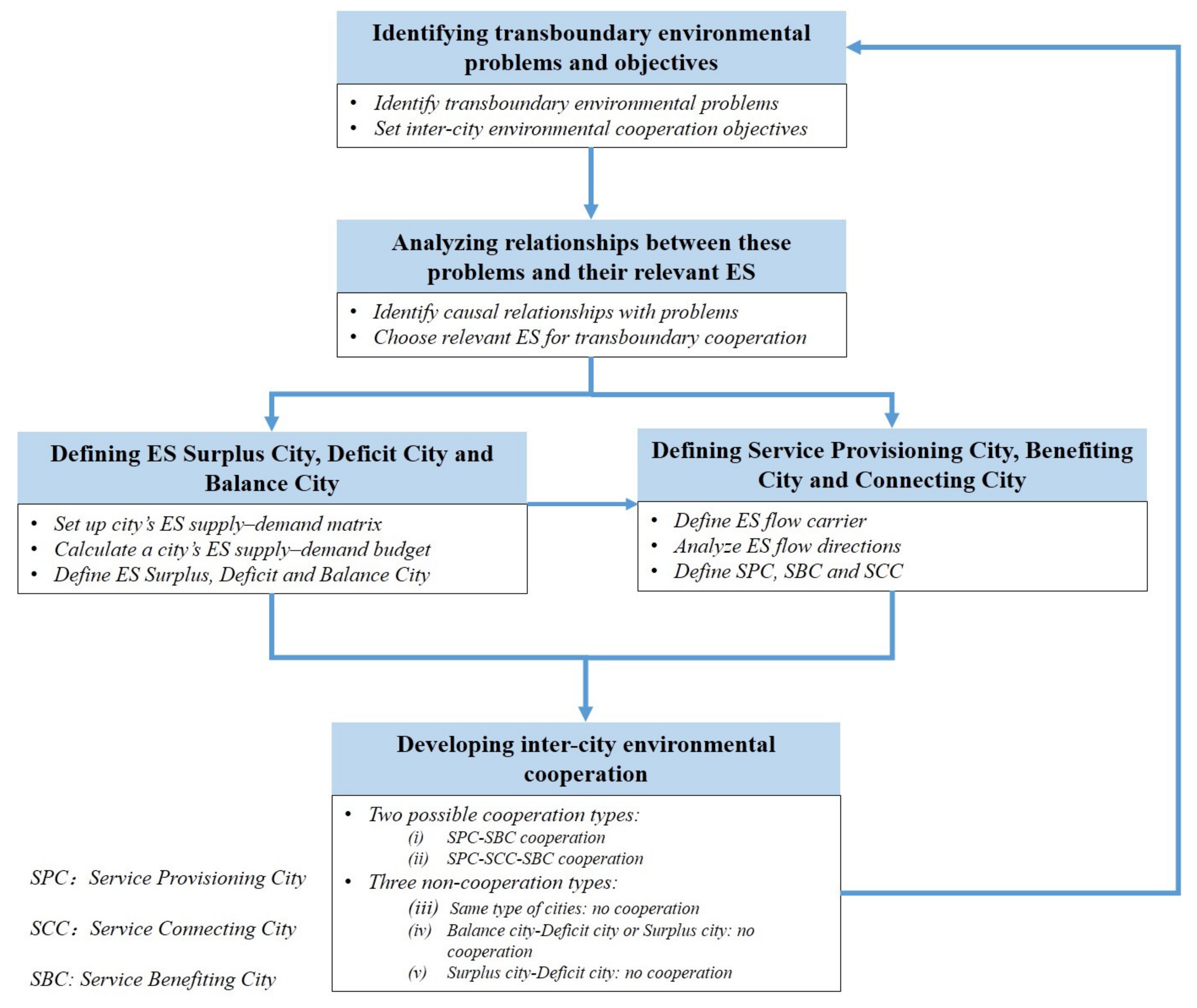
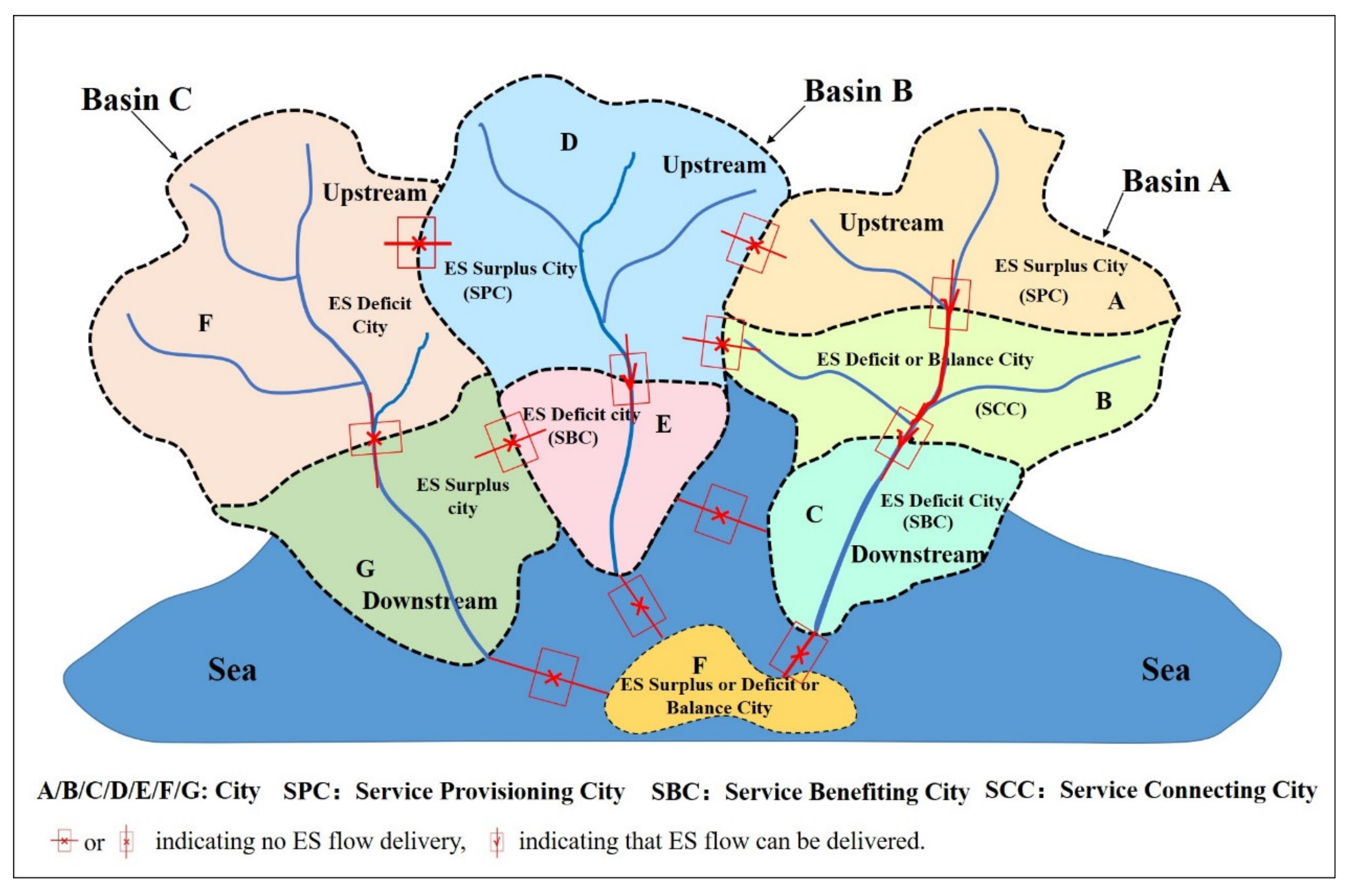
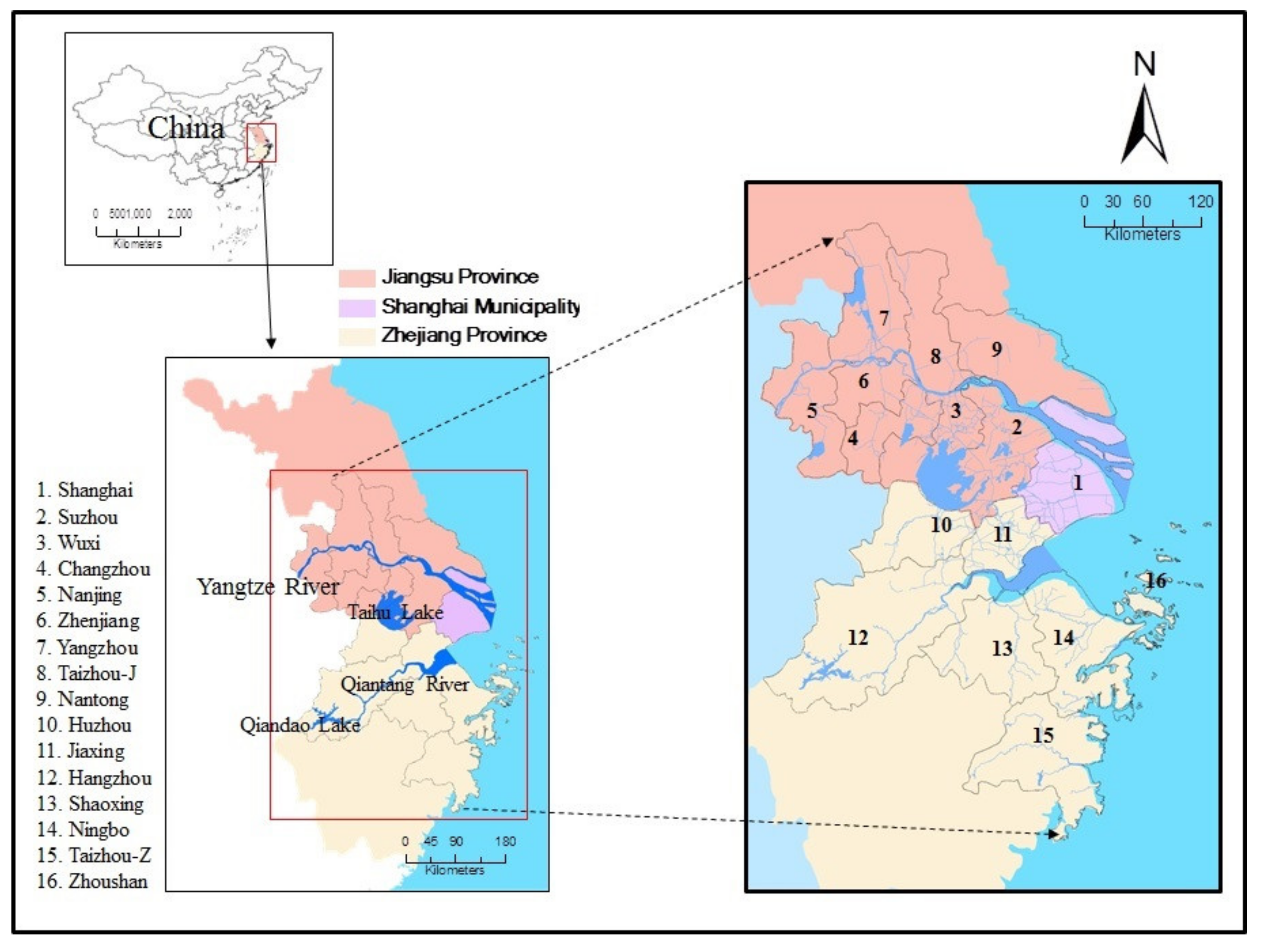
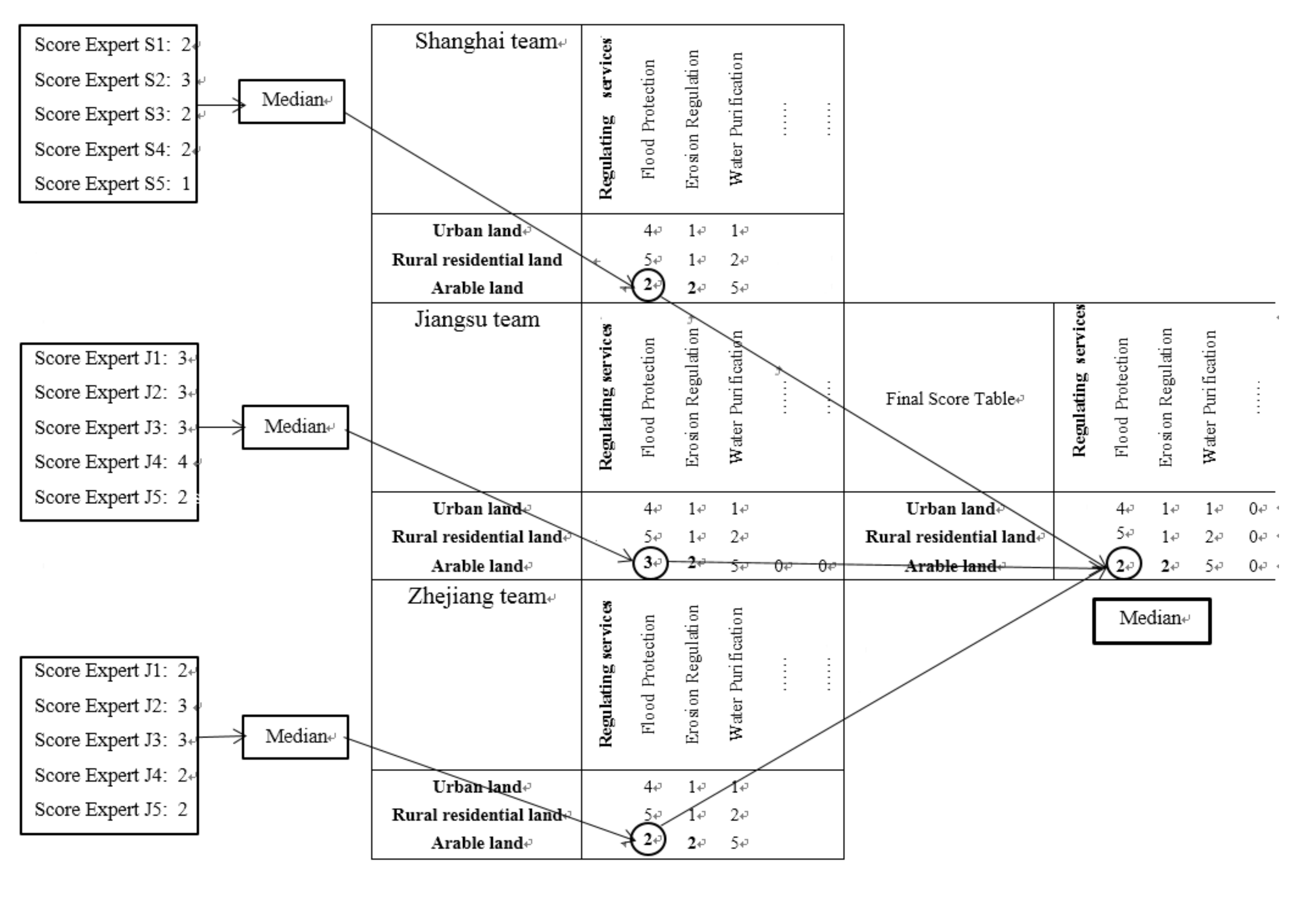

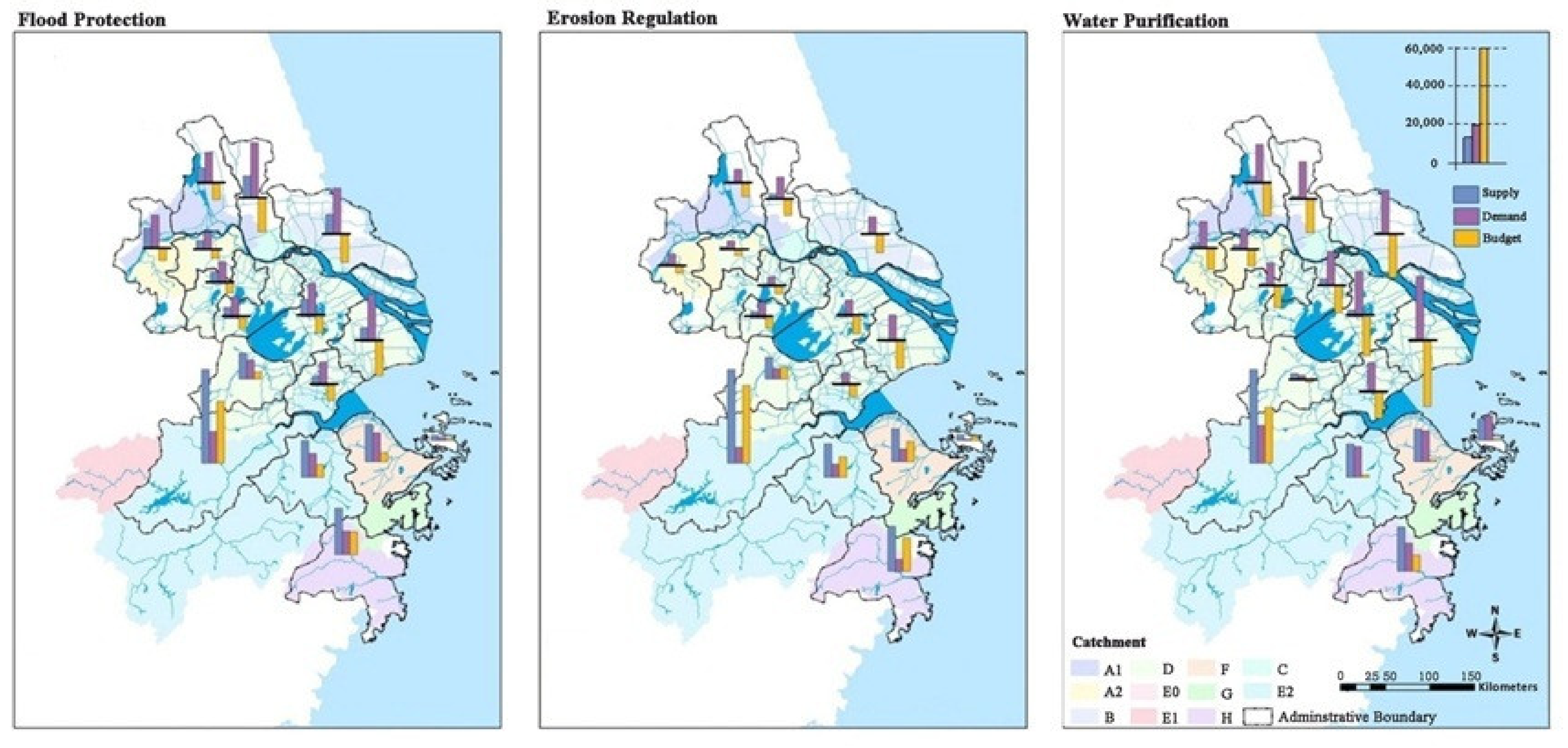
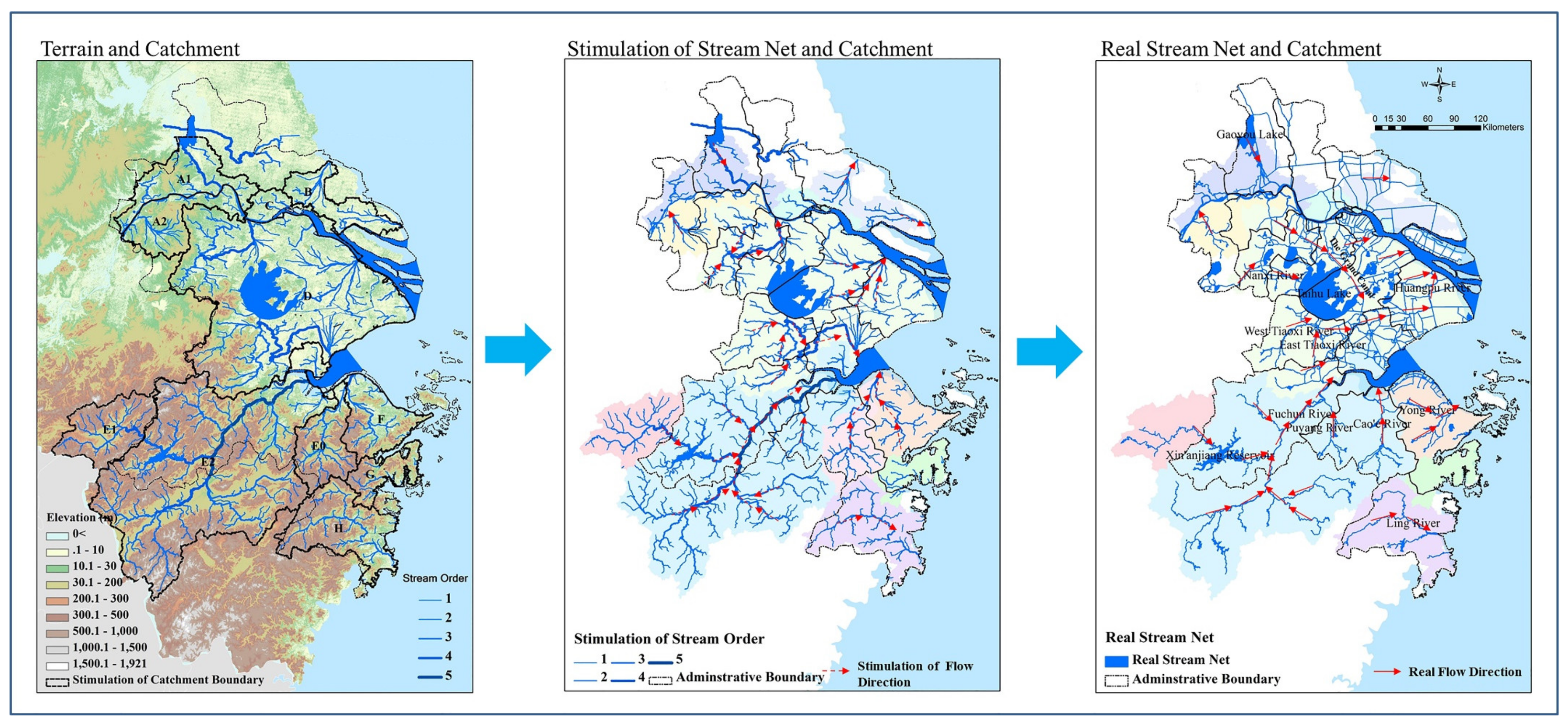
| Concept | Definition | References |
|---|---|---|
| Ecosystems Services (ES) Supply of a City | ES supply means the provision of a service by a particular ecosystem. We define the ES supply of a city as the provision of a service by all of the ecosystems in that city. | Defined following [20,29] |
| ES Demand of a City | ES demand refers to the need for specific ES by a society, particularly stakeholder groups or individuals. We define the ES demand of a city as the corresponding need of that city. | Defined following [20,29] |
| ES Supply–Demand Budget of a City | Each field in the budget matrix can be calculated based on the corresponding field in the supply and the demand matrix. We define the ES supply–demand budget of a city as the sum of differences between ES supply and demand of a city. | Defined following [20,29] |
| ES Surplus City | A city in which ES supply is greater than demand in an ES supply–demand budget. | Defined in this study |
| ES Deficit City | A city in which ES demand is greater than supply in an ES supply–demand budget. | Defined in this study |
| ES Balance City | A city in which ES supply is equal to ES demand. | Defined in this study |
| Service Provisioning City (SPC) | Service provisioning area refers to an area that is the source of an ES or multiple ES. We define SPC as a city that is the source of an ES or multiple ES. | Defined following [17,20,21,22,29] |
| Service Benefiting City (SBC) | Service benefiting area means an area benefiting from an ES or multiple ES. We define SBC as a city benefitting from an ES or multiple ES. | Defined following [17,20,21,22,29] |
| Service Connecting City (SCC) | Service connecting area refers to the intervening space between providing and benefiting areas, if the latter two are not contiguous. We define an intervening city as SCC between SPC and SBC if SPC and SBC do not border each other. An SCC can be an ES Deficit City or ES Balance City. | Defined following [17,20,21,22,29] |
| Intercity ES flow | Ecosystem service flows refer to the spatial and temporal connections between provisioning and benefiting areas. We define Intercity ES flow as the spatial and temporal connections between SPC and SBC. | Defined following [17,20,21,22,29] |
| Level | Name | Year | Number | Reference |
|---|---|---|---|---|
| National | Regional Plan for the Yangtze River Delta Region (2009–2020) | 2010 | 1 | [62] |
| Regional | Comprehensive Ecological Risk Prevention: Natural Disaster Factors and Risk Assessment in the Yangtze River Delta Region | 2014 | 1 | [63] |
| Regional | The Health Status Report of Taihu Lake | 2008–2017 | 10 | [60] |
| Regional | Annual Report of Flood Control and Typhoon Prevention in Taihu Lake Basin | 2013–2018 | 6 | [64] |
| Municipal | Annual Report on the Resources and Environment of Shanghai | / | 1 | [68] |
| Land Cover | Flood Protection | Erosion Regulation | Water Purification | ||||||
|---|---|---|---|---|---|---|---|---|---|
| S | D | B | S | D | B | S | D | B | |
| Urban Land | 0 | 4 | –4 | 0 | 1 | –1 | 0 | 1 | –1 |
| Rural Residential Land | 0 | 5 | –5 | 0 | 1 | –1 | 0 | 2 | –2 |
| Arable Land | 1 | 2 | –1 | 0 | 2 | –2 | 0 | 5 | –5 |
| Forest | 3 | 0 | 3 | 5 | 0 | 5 | 5 | 0 | 5 |
| Shrublands | 0 | 0 | 0 | 4 | 0 | 4 | 4 | 0 | 4 |
| Grasslands | 1 | 0 | 1 | 5 | 0 | 5 | 4 | 0 | 4 |
| Barelands | 4 | 0 | 4 | 0 | 0 | 0 | 0 | 0 | 0 |
| Inland Marshes | 5 | 0 | 5 | 0 | 0 | 0 | 0 | 0 | 0 |
| Salt Marshes | 1 | 0 | 1 | 0 | 0 | 0 | 0 | 0 | 0 |
| Streams and Lakes | 1 | 0 | 1 | 0 | 0 | 0 | 1 | 0 | 1 |
| Estuaries | 3 | 0 | 3 | 0 | 0 | 0 | 2 | 0 | 2 |
| Shallow Sea Wetlands | 0 | 0 | 0 | 0 | 0 | 0 | 0 | 0 | 0 |
| Province | City | Flood Protection | Erosion Regulation | Water Purification | |||||||
|---|---|---|---|---|---|---|---|---|---|---|---|
| S | D | B | S | D | B | S | D | B | |||
| Zhejiang | Hangzhou | 37,192.95 | 12,580.05 | 24,612.90 | 55,799.76 | 9391.44 | 46,408.32 | 55,957.51 | 22,521.72 | 33,435.79 | |
| Taizhou-Z | 18,362.32 | 9325.78 | 9036.54 | 26,752.79 | 6980.61 | 19,772.18 | 26,446.62 | 16,834.84 | 9611.78 | ||
| Shaoxing | 14,605.68 | 9538.62 | 5067.06 | 20,025.34 | 7837.11 | 12,188.23 | 19,921.69 | 18,463.31 | 1458.38 | ||
| Ningbo | 14,858.42 | 11,445.92 | 3412.50 | 19,632.80 | 7557.60 | 12,075.20 | 19,586.43 | 18,407.13 | 1179.30 | ||
| Zhoushan | 2077.04 | 1321.10 | 755.94 | 3371.65 | 904.39 | 2467.26 | 12,845.27 | 14,903.94 | 1030.80 | ||
| Huzhou | 10,325.05 | 7494.54 | 2830.51 | 12,942.15 | 6077.47 | 6864.68 | 3216.32 | 2185.52 | –2058.67 | ||
| Jiaxing | 3480.89 | 9370.37 | –5889.48 | 127.35 | 7023.49 | –6896.14 | 305.90 | 16,916.21 | –16,610.31 | ||
| Jiangsu | Zhenjiang | 3803.69 | 7120.00 | –3316.31 | 2046.60 | 5407.04 | –3360.44 | 3028.50 | 12,615.93 | –9587.43 | |
| Changzhou | 4400.34 | 8398.65 | –3998.31 | 1306.05 | 5780.17 | –4474.12 | 1588.60 | 14,191.99 | –12,603.39 | ||
| Nanjing | 4367.53 | 8502.00 | –4134.47 | 1523.20 | 6359.68 | –4836.48 | 2121.72 | 15,301.62 | –13,179.90 | ||
| Wuxi | 7518.65 | 12,715.24 | –5196.59 | 3857.05 | 9797.13 | –5940.08 | 3871.93 | 20,291.54 | –16,419.61 | ||
| Yangzhou | 6364.86 | 12,617.43 | –6252.57 | 1062.08 | 8663.64 | –7601.56 | 4592.32 | 23,686.96 | –19,094.64 | ||
| Taizhou-J | 7011.37 | 13,383.05 | –6371.68 | 2750.85 | 12,762.03 | –10,011.18 | 1532.09 | 21,984.08 | –20,451.99 | ||
| Suzhou | 8116.22 | 18,625.45 | –10,509.23 | 151.95 | 10,186.31 | –10,034.36 | 3984.11 | 27,163.26 | –23,179.15 | ||
| Nantong | 8983.04 | 22,245.66 | –13,262.62 | 295.10 | 10,879.19 | –10,584.09 | 1286.16 | 26,810.37 | –25,524.21 | ||
| Shanghai | Shanghai | 5488.08 | 19,036.37 | –13,548.29 | 10.44 | 15,915.92 | –15,905.48 | 325.21 | 39,122.35 | –38,797.14 | |
| Total | 156,956.13 | 183,720.23 | –18,951.35 | 151,655.16 | 131,523.22 | 20,131.94 | 160,610.38 | 311,400.77 | –150,790.39 | ||
© 2020 by the authors. Licensee MDPI, Basel, Switzerland. This article is an open access article distributed under the terms and conditions of the Creative Commons Attribution (CC BY) license (http://creativecommons.org/licenses/by/4.0/).
Share and Cite
Cai, W.; Wu, T.; Jiang, W.; Peng, W.; Cai, Y. Integrating Ecosystem Services Supply–Demand and Spatial Relationships for Intercity Cooperation: A Case Study of the Yangtze River Delta. Sustainability 2020, 12, 4131. https://doi.org/10.3390/su12104131
Cai W, Wu T, Jiang W, Peng W, Cai Y. Integrating Ecosystem Services Supply–Demand and Spatial Relationships for Intercity Cooperation: A Case Study of the Yangtze River Delta. Sustainability. 2020; 12(10):4131. https://doi.org/10.3390/su12104131
Chicago/Turabian StyleCai, Wenbo, Tong Wu, Wei Jiang, Wanting Peng, and Yongli Cai. 2020. "Integrating Ecosystem Services Supply–Demand and Spatial Relationships for Intercity Cooperation: A Case Study of the Yangtze River Delta" Sustainability 12, no. 10: 4131. https://doi.org/10.3390/su12104131
APA StyleCai, W., Wu, T., Jiang, W., Peng, W., & Cai, Y. (2020). Integrating Ecosystem Services Supply–Demand and Spatial Relationships for Intercity Cooperation: A Case Study of the Yangtze River Delta. Sustainability, 12(10), 4131. https://doi.org/10.3390/su12104131







